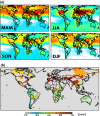Current and future ozone risks to global terrestrial biodiversity and ecosystem processes
- PMID: 28035269
- PMCID: PMC5192800
- DOI: 10.1002/ece3.2568
Current and future ozone risks to global terrestrial biodiversity and ecosystem processes
Abstract
Risks associated with exposure of individual plant species to ozone (O3) are well documented, but implications for terrestrial biodiversity and ecosystem processes have received insufficient attention. This is an important gap because feedbacks to the atmosphere may change as future O3 levels increase or decrease, depending on air quality and climate policies. Global simulation of O3 using the Community Earth System Model (CESM) revealed that in 2000, about 40% of the Global 200 terrestrial ecoregions (ER) were exposed to O3 above thresholds for ecological risks, with highest exposures in North America and Southern Europe, where there is field evidence of adverse effects of O3, and in central Asia. Experimental studies show that O3 can adversely affect the growth and flowering of plants and alter species composition and richness, although some communities can be resilient. Additional effects include changes in water flux regulation, pollination efficiency, and plant pathogen development. Recent research is unraveling a range of effects belowground, including changes in soil invertebrates, plant litter quantity and quality, decomposition, and nutrient cycling and carbon pools. Changes are likely slow and may take decades to become detectable. CESM simulations for 2050 show that O3 exposure under emission scenario RCP8.5 increases in all major biomes and that policies represented in scenario RCP4.5 do not lead to a general reduction in O3 risks; rather, 50% of ERs still show an increase in exposure. Although a conceptual model is lacking to extrapolate documented effects to ERs with limited or no local information, and there is uncertainty about interactions with nitrogen input and climate change, the analysis suggests that in many ERs, O3 risks will persist for biodiversity at different trophic levels, and for a range of ecosystem processes and feedbacks, which deserves more attention when assessing ecological implications of future atmospheric pollution and climate change.
Keywords: Community Earth System Model; G200 ecoregions; air pollution; atmospheric feedback; global climate change; species diversity.
Figures




Similar articles
-
Impacts of elevated atmospheric CO2 and O3 on forests: phytochemistry, trophic interactions, and ecosystem dynamics.J Chem Ecol. 2010 Jan;36(1):2-21. doi: 10.1007/s10886-009-9731-4. J Chem Ecol. 2010. PMID: 20054619 Review.
-
Interactive effects of ozone depletion and climate change on biogeochemical cycles.Photochem Photobiol Sci. 2003 Jan;2(1):51-61. doi: 10.1039/b211154n. Photochem Photobiol Sci. 2003. PMID: 12659539 Review.
-
Global assessment of nitrogen deposition effects on terrestrial plant diversity: a synthesis.Ecol Appl. 2010 Jan;20(1):30-59. doi: 10.1890/08-1140.1. Ecol Appl. 2010. PMID: 20349829
-
Climate change impacts on human health over Europe through its effect on air quality.Environ Health. 2017 Dec 5;16(Suppl 1):118. doi: 10.1186/s12940-017-0325-2. Environ Health. 2017. PMID: 29219103 Free PMC article. Review.
-
The Minderoo-Monaco Commission on Plastics and Human Health.Ann Glob Health. 2023 Mar 21;89(1):23. doi: 10.5334/aogh.4056. eCollection 2023. Ann Glob Health. 2023. PMID: 36969097 Free PMC article. Review.
Cited by
-
Investigating Changes in Ozone Formation Chemistry during Summertime Pollution Events over the Northeastern United States.Environ Sci Technol. 2022 Nov 15;56(22):15312-15327. doi: 10.1021/acs.est.2c02972. Epub 2022 Oct 11. Environ Sci Technol. 2022. PMID: 36219092 Free PMC article.
-
Plant-mediated effects of ozone on herbivores depend on exposure duration and temperature.Sci Rep. 2019 Dec 27;9(1):19891. doi: 10.1038/s41598-019-56234-z. Sci Rep. 2019. PMID: 31882632 Free PMC article.
-
Model-based estimation of the leaf area of ozone-indicator tobacco (Nicotiana tabacum L.) plants under ambient ozone conditions.MethodsX. 2023 May 10;10:102214. doi: 10.1016/j.mex.2023.102214. eCollection 2023. MethodsX. 2023. PMID: 37205180 Free PMC article.
-
The impact of Climate Change on the Western Pacific Subtropical High and the related ozone pollution in Shanghai, China.Sci Rep. 2019 Nov 18;9(1):16998. doi: 10.1038/s41598-019-53103-7. Sci Rep. 2019. PMID: 31740774 Free PMC article.
-
Novel strategies and advancement in reducing heavy metals from the contaminated environment.Arch Microbiol. 2022 Jul 13;204(8):478. doi: 10.1007/s00203-022-03087-2. Arch Microbiol. 2022. PMID: 35831495 Review.
References
-
- Agrell, J. , Kopper, B. , McDonald, E. P. , & Lindroth, R. L. (2005). CO2 and O3 effects on host plant preferences of the forest tent caterpillar (Malacosoma disstria). Global Change Biology, 11, 588–599.
-
- Anav, A. , De Marco, A. , Proietti, C. , Alessandri, A. , Dell'Aquila, A. , Cionni, I. , … Vitale, M. (2016). Comparing concentration‐based (AOT40) and stomatal uptake (PODY) metrics for ozone risk assessment to European forests. Global Change Biology, 22, 1608–1627. - PubMed
-
- Andersen, C. P. (2003). Source‐sink balance and carbon allocation below ground in plants exposed to O3 . New Phytologist, 157, 213–228. - PubMed
-
- Aneja, M. K. , Sharma, S. , Fleischmann, F. , Stich, S. , Heller, W. , Bahnweg, G. , … Schloter, M. (2007). Influence of ozone on litter quality and its subsequent effects on the initial structure of colonizing microbial communities. Microbial Ecology, 54, 151–160. - PubMed
-
- Arbaugh, M. J. , & Bytnerowicz, A. (2003). Ambient ozone patterns and effects over the Sierra Nevada: Synthesis and implications for future research. Developments in Environmental Science, 2, 249–261.
Publication types
LinkOut - more resources
Full Text Sources
Other Literature Sources
Miscellaneous

